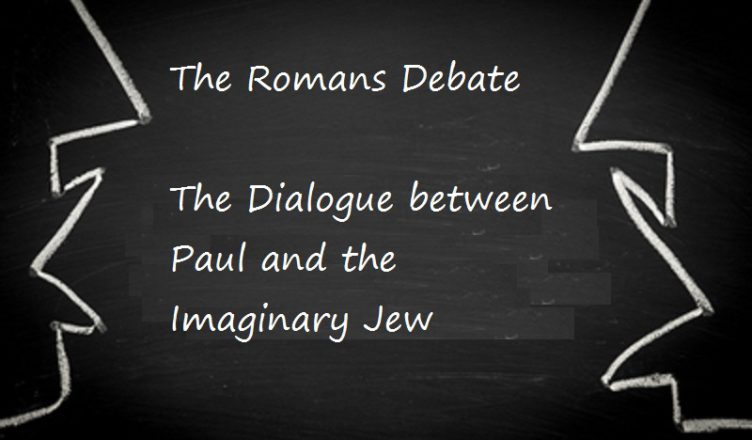 Welcome again to this series of posts on the dialogue in Romans. It gives a basic outline of the sequence from the initial creation of Romans, its transportation to the Roman Church, and the probable method it would have been received by the Roman Church.
Welcome again to this series of posts on the dialogue in Romans. It gives a basic outline of the sequence from the initial creation of Romans, its transportation to the Roman Church, and the probable method it would have been received by the Roman Church.
Here is a link to the first post which has the contents of all.
Today I will give you a sneak peak at the scripted Romans 1-4 dialogue between Paul and IJ, the imaginary Jew.
The main points I made from my previous posts are;
- D1) Paul spoke the text aloud in front of his scribe Tertius who wrote it down (Rom 16.22; 11.13).
- D2) The Roman audience had the text read out aloud in front of them.
- D3) The Roman audience consisted of Jewish and Gentile believers (Rom 1.8).
- D4) An unassisted forward reading of the Romans 1-4 is contradictory and confusing because
- D5) In the letter Paul is speaking to an imaginary Jew (IJ) in front of the Roman believers (Rom 2.17, cf 2.1-29).
- D6) The interaction between Paul and IJ dominates most of Romans 1-4
- a) Paul and IJ speak to one another (cf. Rom 3.1-9; 3.27-4.1).
- b) Paul is responding to IJ who has judged Greeks (cf. 1.18-32; 2.1-5; Rom 3.9b).
Recalling from the previous section, my proposal for how the audience was intended to understand the switches between Paul and IJ is;
- Paul dictated the letter to Tertius and performed it in such a manner as to make these switches clear.
- Paul would have created stage instructions for the letter bearer to either use herself or pass on to the lector to enable the audience to distinguish between speakers.
- The lector would have spoken to the audience beforehand so they knew what was being read out contained a dialogue between Paul and an imaginary Jew.
- The lector would be trained to posit non-verbal clues such as changes in tone, timing, facial expressions, gesture, posture, distance, and movement. These would allow the audience to distinguish between speakers and whom was being spoken to.
Just like any stage performance.
One person would have performed this text. In the historical context, this was the letter bearer and/or the reader. Paul’s training of the letter bearer’s would prepare them to perform the text just as Paul did before his scribe. Their performance would allow the Roman Christian audience to tell who was speaking to whom.
For clarity, the cartoons I have drawn show two people. These are representations of Paul and IJ, in order to make it clear who is speaking and whom is being spoken to as we look at the text. I acknowledge it likely only a single person performed the text, however for clarity in my paper the cartoons show two people.
In summary, the overall conclusion I drew from the text was that the dialogue between Paul and IJ dominates most of Romans 1-4. This dialogue was performed in front of the Roman audience consisting of both Jewish and Gentile believers. So now I will give you a sneak peek of what the performance of Romans 1.16-4.25 would have looked like.
Rom 1.1-15
The lector has been prepared regarding the contents of the letter and begins reading it out loud to the Roman believers. When the lector reads the letter, he or she speaks representing Paul to the audience.

Rom 1.16-17
Paul’s speech to the Roman believers continues.

Rom 1.18-27
At this point the lector announces to the congregation the following section is a dialogue between Paul (whom he represents by reading the letter) and an imaginary Jew (IJ).
This will allow the congregation to understand what is happening and avoid possible confusion, especially when he reads out Rom 2.1-5.
The lector positions his body to speak as if to an imaginary Jew, and not the Roman Christian audience.
Ive drawn the bubbles coming from IJ to highlight that Paul’s condemnation is very similar, if not the same as IJ’s. Paul says IJ makes the same judgment in Rom 2.1-5.


Rom 1.28-2.5
The lector may remind the audience again of the dialogue and that he has been speaking to IJ. He does this so they don’t assume Paul is speaking to them.
Paul’s speech to IJ continues.

Rom 2.6-16
Paul’s speech to IJ continues.

Rom 2.17-29
Paul’s speech to IJ continues.

Rom 3.1-8
The general flow is structured by the questions and answers. These mark off who is speaking to whom.
The lector switches back and forth between Paul and IJ accordingly.

Rom 3.9-20
The question is again IJ’s, the extended answer afterward is Paul’s.
The lector switches from IJ to Paul accordingly.

Rom 3.21-26
Paul’s speech to IJ continues.

Rom 3.27-31
The general flow structured by the questions and answers marks of who is speaking to whom. There are some rhetorical questions in Rom 3.29. These are included by the lector in Paul’s voice because they promote Paul’s argument.
The lector switches back and forth between Paul and IJ accordingly.

Rom 4.1-8
The question is again IJ’s, the extended answer after is Paul’s.

Rom 4.9-22
Paul’s speech to IJ continues.
There are some rhetorical questions in Rom 4.9-10. These are included by the lector in Paul’s voice because they promote Paul’s argument.

Rom 4.23-25
The lector now signifies the end of the dialogue by changing his orientation towards the Roman believers and resumes eye contact with them. He may verbalise the dialogue has terminated if he is unsure the change has not been made clear to them.

Rom 5.1-11
Paul continues addressing the Roman believers.

Copyright © Joshua Washington and thescripturesays, 2014. All Rights Reserved.


